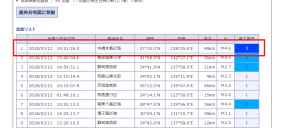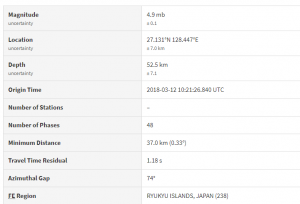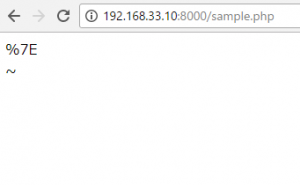まず気象庁
———–
地震の発生日時 震央地名 緯度 経度 深さ M 最大震度
1 2018/03/12 19:21:26.0 沖縄本島近海 27°15.0′N 128°25.6′E 48km M4.6 3

USGS
———-
Magnitude
uncertainty
4.9 mb
± 0.1
Location
uncertainty
27.131°N 128.447°E
± 7.0 km
Depth
uncertainty
52.5 km
± 7.1
Origin Time 2018-03-12 10:21:26.840 UTC
Number of Stations –
Number of Phases 48
Minimum Distance 37.0 km (0.33°)
Travel Time Residual 1.18 s
Azimuthal Gap 74°
FE Region RYUKYU ISLANDS, JAPAN (238)

時間はほぼ一緒ですが、マグニチュード、緯度経度、depth、全て値が微妙に異なります。
マグニチュード:地震が発するエネルギーの大きさを対数で表した指標値
地震のエネルギーを1000の平方根を底とした対数で表した数値で、マグニチュードが 1 増えると地震のエネルギーは約31.6倍になり、マグニチュードが 2 増えると地震のエネルギーは1000倍になる
マグニチュード測定方法:地震計
USGS:GPSや地震計を一定間隔で配備して、ネットワーク化、地下深くまでドリルで穴を開けて分析
気象庁とUSGSでは、どちらのデータが精度が高いのか疑問に思ったのですが、
下記資料をざっと流し読みすると、やってる事にあまり違いがないように感じます。
http://www.spaceref.co.jp/homepage/colum/images/US_earthquake_observation.pdf
ということで、今回は、USGSのデータを使って、地震情報をつくっていきたいと思います。


